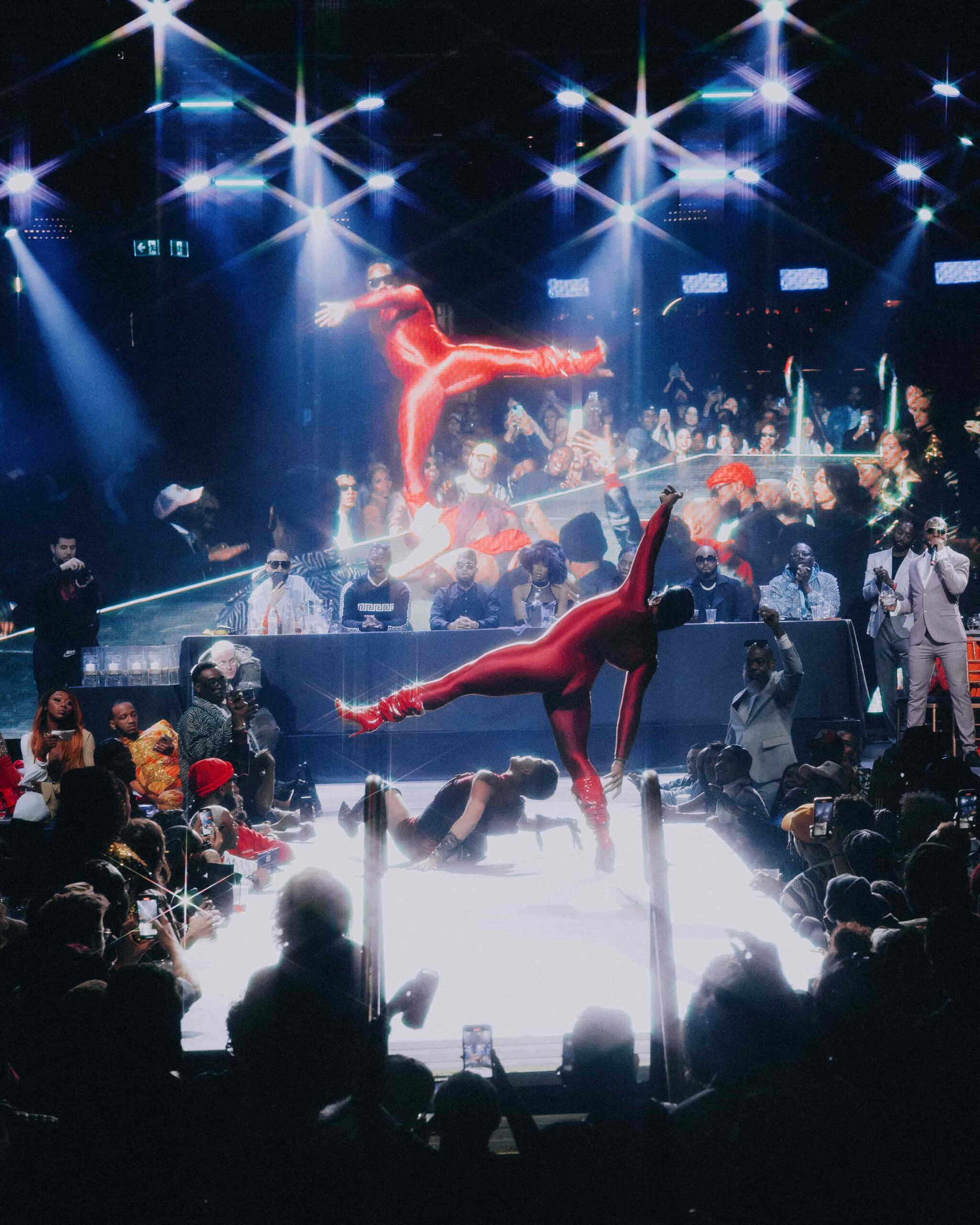When Jazmine Miyake-Mugler hit the back of the runway, her jet-black hair falling just so, the massive, pristine white wings jutting from her back, arching high with the tips almost grazing the floor, she knew the night was hers. Win, lose or draw, she had spent three months putting together the perfect look and glam team to walk the face category—competing against others for not only who had the best bone structure, skin clarity and smile, but who read as the most charismatic and confident. She knew that there was no one in Canada who realistically stood a chance against her.
The wind from a fan made the feathers of the wings start to flutter. There were screams from the crowd as she made her way down the runway to the panel of judges. “The House of Miyake-Mugler has a new gem and she hails from Canada,” the commentator said into the mic. “And her motherfucking name is Jazmine.” The judges knew it was Jazmine’s night too: tens across the board.
Jazmine Miyake Mugler 10s (Toronto, 2022) pic.twitter.com/Cre0JjUDgs
— Vogues’ Best (@VoguesBest) December 4, 2022
This was Toronto’s World AIDS Day Ball put on by Function in 2022 at the live music venue History. It was dubbed the largest ball in Canadian history and Jazmine had one of the biggest moments. After she beat out all other competitors except her house members that night, sponsor Absolut Vodka threw in an additional $3,000 to see the Muglers eschew house rules and compete against each other. And they did, with Jazmine blazing through her housemates before the battle of a lifetime: she had to face off against Exotic Miyake-Mugler, one of the leaders of the House of Miyake-Mugler, an icon for face and a longtime long-distance source of encouragement. This was a man who had been competing for more than 20 years, winning top-dollar prizes across the U.S. and Europe. To the back they went.
“I wept,” Tamar Miyake-Mugler, Jazmine’s mentor and mother within the ballroom scene tells Xtra. “As she came from the back of the runway, I wept an ugly cry—just tears you cannot control. When you see your kid fulfill a dream that to them seemed unattainable, you kind of know that they’ll be okay without you. Like if I die, she’ll be okay. That’s what you train your kids for, to be able to do it themselves.” And with Jazmine’s win that night, a showcase of her creative prowess, she made it clear that she could stand alone.

The wild scene at the World AIDS Day Ball in Toronto in 2022. Credit: Kirk Lisaj
To say that ballroom is at the forefront of culture seems trite at this point. It’s been a statement used and reused since the late 1980s, starting with Malcolm McLaren’s “Deep In Vogue,” Madonna’s “Vogue” and Jennie Livingston’s documentary Paris Is Burning. And, of course, it’s continued throughout the years: America’s Best Dance Crew, Pose, Legendary, Beyoncé’s Renaissance. These projects are often based in the U.S., but their influence has been felt internationally. The lore of Canadian ballroom and voguing claims to date back to the 1980s, but it really began to take shape in the mid-aughts—some refer to it as one of the oldest scenes outside of the U.S.
“Legendary Sevyn from the kiki scene used to travel back and forth from the U.S. to Toronto,” Aura 007, a co-founder of Function, says. “In the clubs [on Church Street] once the actual night was over, DJ Blackcat would pump house and vogue beats and Sevyn would vogue in the corner. Back then, Twysted, Snoopy and a bunch of these people were in a dance crew and would see him.”
That group took a liking to the dance form, began to learn it and became the pioneers of the Toronto scene, opening the House of Monroe in 2006. Now the community is flush with international houses establishing chapters across Canada year after year. They are expected to turn out in force at History this Saturday for the World AIDS Day Ball produced by Function, which has become a common site for house debuts in three short years.
Jazmine wouldn’t get her introduction until 12 years after Monroe’s founding as part of the third or fourth (depending on who you ask) generation of the Toronto scene. At 18 years old, she was pre-transition and a self-described “suburbs kid” who was raised on RuPaul’s Drag Race. But she didn’t feel like she fit in with the community she found in Toronto’s downtown gay village. Already practising drag on her own, her first experience at a ball—the 2018 Starlight, Dark Night ball at The 519 community centre—was transformative.
“For the first time, I actually really felt like I belonged somewhere,” she says. “That I fit in and there were other people who looked like me. I didn’t feel like the odd one out or that I had this exaggerated idea of what I wanted to be.”
There she met Tamar, who was at the time opening the House of Louboutin within ballroom’s kiki scene. The kiki community is a subgenre of ballroom generally thought to cater to the scene’s youngest participants, prizing community and low-stakes creativity over the power play the mainstream scene has become. That night, in what they both describe as a cinematic freeze-frame moment, Tamar made Jazmine a promise.
“She held my hand and said to me, verbatim: ‘Little girl, if you trust me blindly, I can give you anything and everything you want in this world,’” Jazmine recounts. “‘Let me know where you want to be and where you want to go and I’ll show you how to get it.’”

Jazmine Miyake-Mugler walking the runway during the World AIDS Day Ball in 2022. Credit: Kirk Lisaj
In short order, under Tamar’s tutelage and her own ambition, Jazmine has become a star of the face category, which is widely viewed as one of the highest of honours on the floor. She’s become the one to beat in Canada—in Toronto, the kiki scene grossly outnumbers the mainstream scene and she reigns as the founding mother of the House of Dior’s Canadian chapter. She’s also stepped into herself, coming to identify as a trans woman in 2020 and putting the skills she learned in the category of realness to work in daily life. That category has caused much contention in the Canadian scene—grading on the ability to “pass” as a cis, hetrosexual person, it was the source of criticism of the 2015 World Stage ball hosted by the now-closed House of Nuance. For Jazmine, whose first category was drag realness (the purpose is to pass as a cis woman) the category equipped her not with a rule or beauty standard to uphold, but with self-awareness for self-preservation.
“It’s not teaching you self-awareness to be scared, but it teaches you self-awareness to protect yourself,” she says. In addition to lessons in humility, Tamar helped open Jazmine’s eyes to the dangers of being visibly trans or queer in public life. “It’s really about how we can get home safely knowing these are the facts.”
Jazmine also has become an advocate, working at the Canadian Foundation for AIDS Research. And she’s become a contender of note in New York, the mecca of ballroom, where she’s battled about six times. In October, she walked a much-anticipated $10,000 face category, against the leading names of the scene. This time she appeared at the back of the runway in a black dress, rippling veil and sheer, elbow-length gloves. Running her tongue across her teeth, she got her hard-earned tens from a stern panel of pioneers of the category. And she battled her way through the pack of competitors, running the back of her hand across her forehead, gliding her fingertips across her jawline, turning just so that the light reflected off of her perfect cheekbones. The performance of it all served her well, making it to the second to the last battle, and losing only to the eventual winner, then legend, now icon Lola Gucci. Quite the showing for a ball she’d only been preparing for over two weeks.
“I took it as a learning curve—I looked good, but I didn’t look like $10,000,” she says of the moment. But seeing what she could accomplish with so little preparation has opened her eyes to what’s possible when she really devotes herself. “I’m ready to go dance with the girls. I want to go out there and prove myself.”
The World AIDS Day Ball is Saturday, Dec. 2, in Toronto.


 Why you can trust Xtra
Why you can trust Xtra


